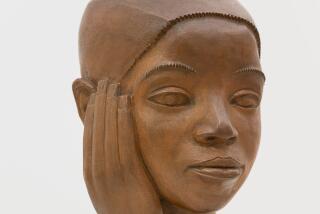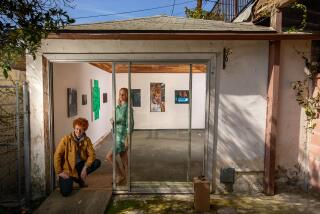CRENSHAW : A Return to Form for Kabasa Gallery
Jae Jai Johnson is serving notice: Kabasa Gallery is back.
And not a moment too soon for Johnson, a tireless purveyor of African and African American culture who believes his establishment is crucial to the continued growth of the local black arts scene.
“The similarities between Africans and Americans--the drums, the art, the music--is too great,” said the 43-year-old drummer and self-described patron of the arts. “We have to find that common ground. That’s why I created this place, a place where people can come to enact their dreams and visions.”
Founded by Johnson in 1990, Kabasa has recently risen phoenix-like from the ashes of a fire in June that claimed most of Johnson’s $100,000 art collection--among the largest personal archives of such art in the area.
Amassed over 20 years and during numerous trips to Africa, the collection included works by such artists as Theresa Tolliver, plus a wealth of sculptures, ceramics and textiles that Johnson picked up in Ghana, the Ivory Coast, Mali and other countries. The gallery now displays what is left of what Johnson calls his life’s work.
“I couldn’t believe it. It was like a nightmare,” Johnson said of the morning he drove up to his gallery to find it gutted. “Art used to cover all the walls. But what happened wasn’t a negative. It just gives room for other people to come up behind me and do their thing,” such as donate art, create new works or perform.
Kabasa, at 3205 W. 54th St., just east of Crenshaw Boulevard, has a wide-open feel and creative atmosphere that would surprise visitors coming through the deceptively drab outer door for the first time.
Glossy hardwood floors are dance-studio perfect; an enormous mirror reflects rows of paintings and other works by African and African American artists. A phalanx of West African drums sits on a raised stage in front of a wall covered by a lively painting from the renowned Caribbean artist Stanley Bernard Hoyes. The work was a gift to Johnson from Hoyes after Kabasa was devastated by the electrical fire in June.
The painting is called “Victory Over Sin,” said Johnson, gesturing toward the its vibrant juxtaposition of late-night revelers with a lone worshiper kneeling before an altar. “That kind of describes this place. . . . I feel very blessed to have it.”
Johnson christened Kabasa’s rebirth last month with the debut of a performance piece titled “Mbari: The Land Is Hot/No Condition Is Permanent.” Last week, home-grown poets Kamauu Daaood, Eric Priestley, Ojenke and K. Curtis Lyle weaved their words around sinuous accompaniments by jazz pianist Horace Tapscott.
In addition to music and poetry performances and lectures, Kabasa offers classes in what Johnson deems vital to the Africa-America connection: West African dance, language, the Brazilian dance and martial art of capoeira, and drumming (Johnson himself gives lessons on playing the dondounbe and kenkeni, West African drums.)
Johnson would like to return to Africa to rebuild the collection amassed in his younger days, but that may prove difficult now that he is the father of three children.
Even if the collection is not what it once was, others are happy to see the gallery return among the thriving artist-run studios on 54th Street.
Fellow drummer and master flute-maker Taumbu, who operates a neighboring gallery and shared space in Kabasa before the fire, said of Johnson: “We work together. We have the same vision. Jae Jai helped me to get where I am. He had to come back.”
Bongo, a clothing designer and manufacturer also located next to Kabasa, said last year’s fire afforded Johnson the opportunity to “purge and make it better. . . . I knew he wasn’t going to leave. We need to draw our wagons together as artists and turn things around.”
Johnson is more than happy to do just that.
“I make my living right here,” he said, pounding the bench on Kabasa’s stage. “I’m here seven days a week, 10 a.m. to 10 p.m. You can come in, and for a small fee, practice music, read, do whatever you like. We’re innovators over here . . . you can come and do it all.”
Information: (213) 294-7580.
More to Read
The biggest entertainment stories
Get our big stories about Hollywood, film, television, music, arts, culture and more right in your inbox as soon as they publish.
You may occasionally receive promotional content from the Los Angeles Times.










